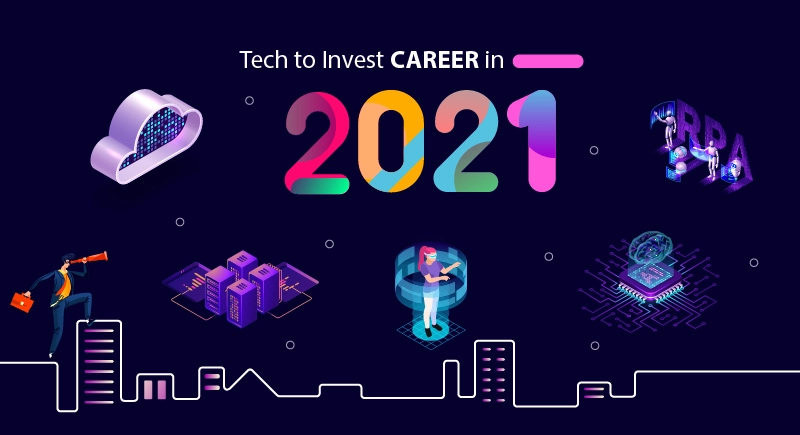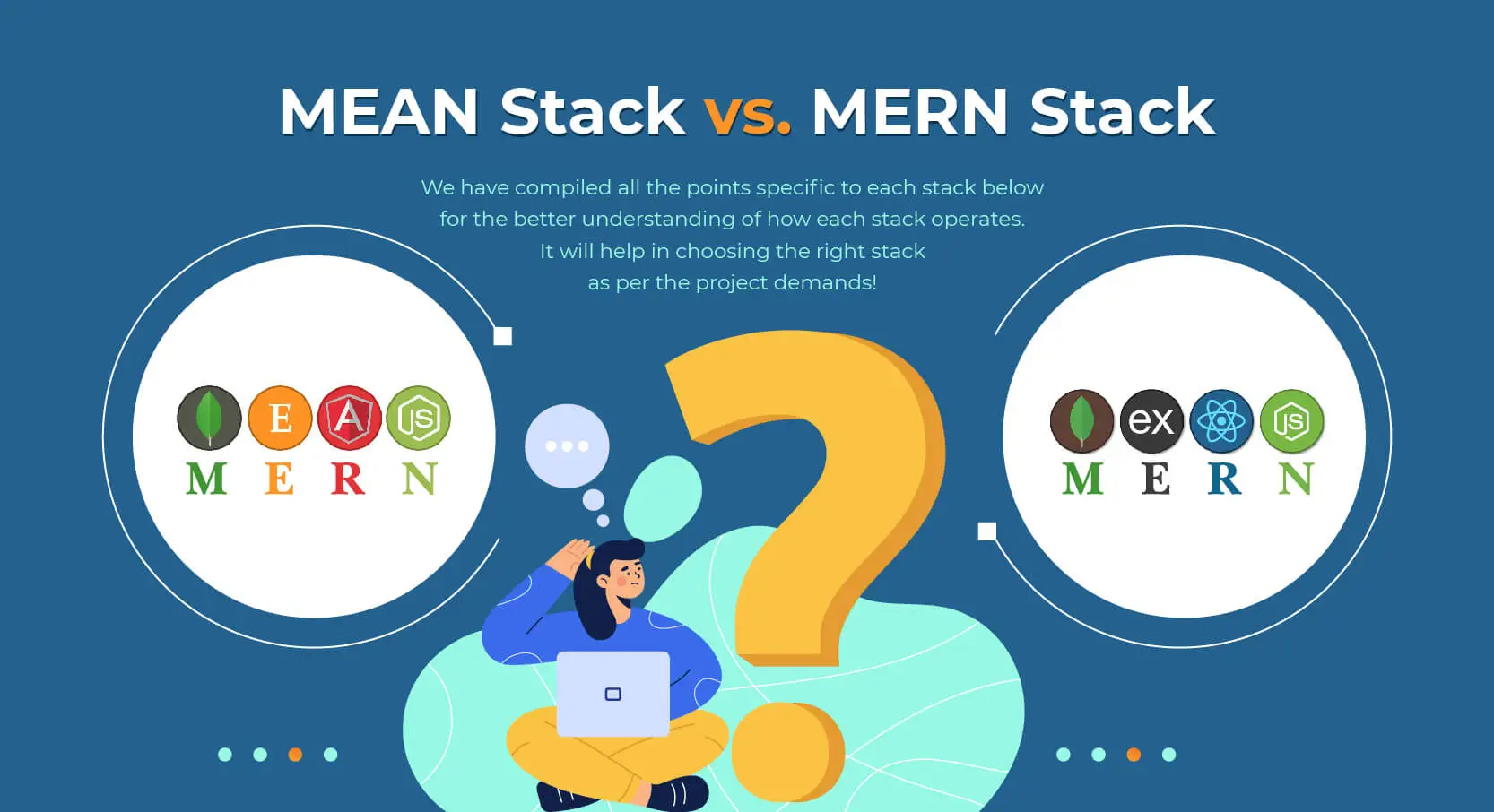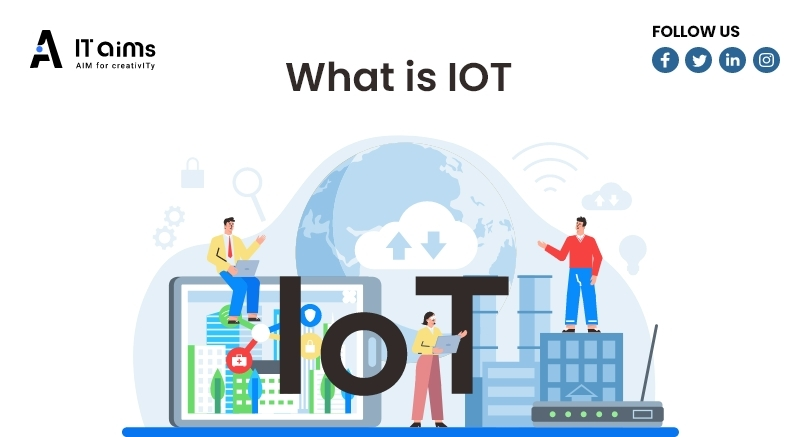
What is IOT ( Internet Of Things) ?
- Overview Of Internet Of Things
- Technology Behind IoT
- How does IOT work?
- What Are Examples Of Iot Devices ?
- What Is Industrial Iot ?
- What Are Iot Applications?
- What Are Iot Technologies?
- How Does Iot Benefit Businesses?
- What is the reason IoT is crucial?
- What are the advantages and disadvantages of IoT?
- How big is the Internet of Things?
- Frequently Asked Question:
Overview Of Internet Of Things
The internet of things, or IoT is a set of that is composed of computing devices interconnected that include mechanical and digital objects, machines, animals or even people who are supplied by unique identification numbers (UIDs) and the capability of transferring data across networks without the need for human-to human or human-to computer interaction. They range from simple household items to advanced industrial equipment. There are more than seven billion IoT devices in the market today. Experts anticipate that number to rise until 10 billion in 2020 and to 22 billion in 2025. In the last couple of decades, IoT has become one of the most significant technologies of the 21st Century. Today, we are able to connect everyday objects such as kitchen appliances, automobiles, thermostats, baby monitors and more to the internet through embedded devices. It's possible to have seamless communication between processes, people and even objects.
Through low-cost computing, cloud, large data analytics, as well as mobile technology physical objects can share and store data without human involvement. In the hyperconnected world of today digital systems are able to monitor, record, and alter every interaction of connected objects. Physical reality meets the digital world and they collaborate. Although the concept of IoT was in the making for quite some time, new developments in a range of different technologies has enabled it to be practical.
Technology Behind IoT
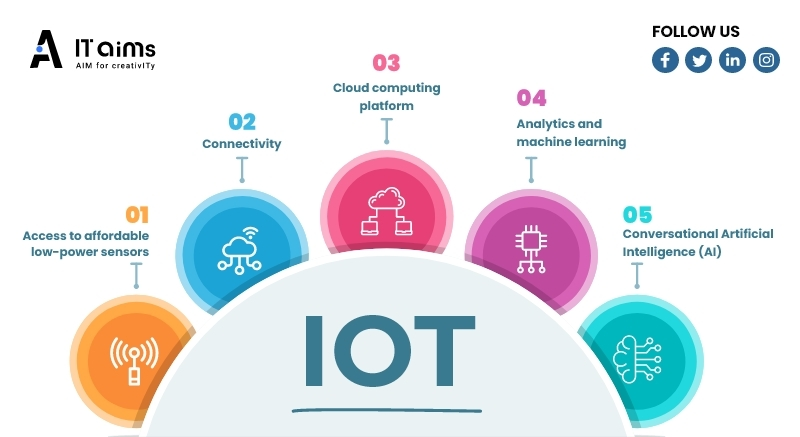
- Access to affordable, low-power sensors. Affordable and reliable sensors make IoT technology available to more companies.
- Connectivity. A host of internet-based network protocols allows users connecting sensor clouds as well as to different "things" for efficient data transfer.
- Cloud computing platform. The increase in the number of cloud platforms allows businesses as well as consumers to have access to the infrastructure needed to expand without needing to manage it all.
- Analytics and machine learning. With advances in machine learning and analytics and access to a variety and massive amount of data that is stored on the cloud, companies can gain insights quicker and more efficiently. The rise of these related technologies is continuing to expand the limits of IoT and the data generated by IoT is also fed by these technologies.
- Conversational Artificial Intelligence (AI). Advances in neural networks have brought natural language processing (NLP) to IoT devices (such as digital personal assistants like Alexa, Cortana, and Siri) and have made them attractive, affordable and practical for use at home.
How does IOT work?
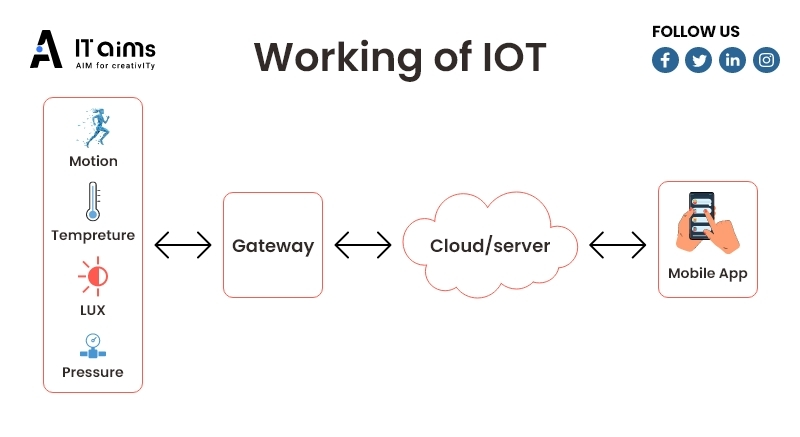
An IoT ecosystem is made up of web-enabled smart devices that make use of embedded systems, like sensors, processors, and communication hardware to gather data, communicate and then act upon data that they collect from their environment. IoT gadgets communicate the data from sensors they gather through a connection with one of the IoT gateway or any other edge devices, where the data is or sent to the cloud for analysis locally or to the cloud for analysis. Sometimes, these devices connect with other devices in the same family and take action based on the data they receive from each other. The devices perform the majority of their work with no human intervention, though people are able to engage with them for instance setting them up, providing them with instructions or access to the information.
The connectivity and networking protocols utilized by these web-enabled devices are largely dependent on the particular IoT applications being used.
IoT can also utilize Artificial Intelligence (AI) or machine learning in making the process of collecting data easier and more flexible.
What Are Examples Of Iot Devices ?
Let's take a look at some examples of IoT systems that are currently in use:
Connected cars
There are numerous ways that automobiles, like cars, can be online. It could be via smart dashcams, infotainment system, as well as the automobile's integrated gateway. They collect information from the brakes, accelerator and speedometers, as well as the odometer, speedometer tanks for fuel and wheels to assess the performance of drivers and the health of the vehicle. Connected cars are able to perform a variety of functions:
- Monitoring the fleet of rental cars to increase efficiency of fuel and cut expenses.
- Helping parents monitor the driving habits that their kids display.
- Notifying family and friends automatically in the event of a car accident.
- Predicting and preventing maintenance requirements.
Connected homes
Smart home devices are designed to improve the safety and efficiency of your home and also enhance the home network. devices like smart outlets track energy usage, and smart thermostats give improved temperature control. Hydroponic systems may use IoT sensors to control the garden, while IoT smoke detectors are able to detect smoke from tobacco. Security systems for homes, such as doors lock, CCTV along with water leak detectors, can detect and stop threats and issue warnings to homeowners.
Connected devices designed for home use can be used to:
- Automatically shutting off devices not being employed.
- Maintenance and management of rental properties.
- Find lost objects like wallets or keys.
- Automating everyday tasks such as vacuuming, making coffee etc.
Smart cities
IoT applications have helped make the process of urban planning and maintenance more efficient. Governments are making use of IoT applications to address issues with health, infrastructure, or the natural environment. IoT applications can be utilized for:
- Monitoring the quality of air and radiation levels.
- Energy savings can be reduced by intelligent lighting systems.
- Monitoring maintenance requirements for vital infrastructures like roads bridges, pipelines, and roads.
- Profits can be increased through effective parking management.
Smart buildings
The buildings of colleges and commercial buildings utilize IoT applications to increase efficiency in operations. IoT devices can be used in smart buildings for:
- Energy consumption reduction.
- Reducing maintenance costs.
- Utilizing workspaces more effectively.
What Is Industrial Iot ?
Industrial IoT (IIoT) is the use of IoT technology within industrial environments, specifically with regard to the measurement and management of devices as well as devices that use cloud technology. In recent times, companies have utilized machine-to-machine communications (M2M) to gain remote control and automation. However, with the advent of cloud technology and other related technologies (such as machine learning and analytics) industries are able to create a new layer of automation and develop new business models and revenue sources. IIoT is often referred to as the 4th wave in the Industrial Revolution called Industry 4.0. Here are some of the most commonly used applications for IIoT
- Intelligent manufacturing
- Connected assets as well as predictive and preventive maintenance
- Smart power grids
- Smart cities
- Connected logistics
- Supply chains that are smart and digital
What Are Iot Applications?
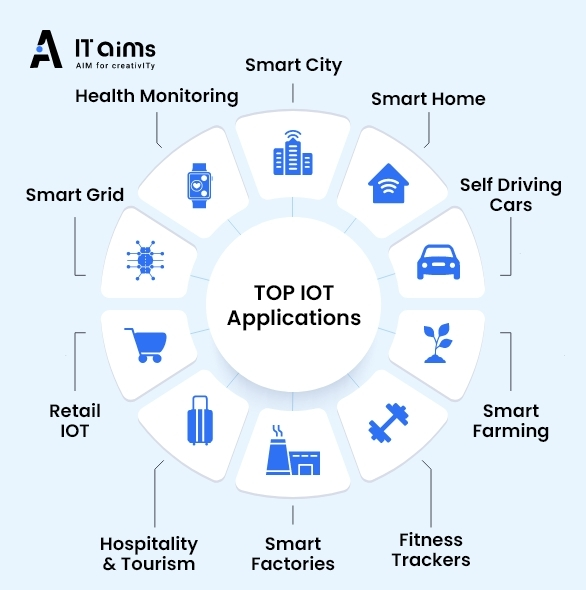
IoT Applications comes with software-as-a-service (SaaS) applications that can analyse and present captured IoT sensor data to business users via dashboards.
IoT applications make use of machine learning algorithms that analyse huge amounts of sensor data connected to the cloud. Utilizing the real-time IoT monitors, alerts, and dashboards you are able to see key performance indicators, stats for the mean time between failures as well as other details. Machine learning-based algorithms can detect anomalies in equipment and issue alerts to the user and initiate automated repairs or preventative countermeasures.
Utilizing cloud-based IoT applications, businesses can easily enhance processes for supply chain management and human resources, customer service as well as financial services. There's no need for rewriting whole business procedures.
What Are Iot Technologies?
Technologies that are used in IoT systems can comprise:
Edge computing
Edge computing is the technology that makes smart devices perform more than send or receive information for the IoT platform. It boosts the power of computing near the edge of an IoT network, which reduces the latency of communication and enhances response times.
Cloud computing
Cloud technology is utilized for remote data storage as well as IoT device management, providing the data to many devices on the network.
Machine learning
Machine learning is the algorithms and software used to analyze data and take real-time decisions based on the information. Machine learning algorithms can be used in the cloud or on the edge.
How Does Iot Benefit Businesses?
As IoT grows more commonplace on the market, businesses are leveraging the immense potential for business benefits it offers. The benefits are:
- Insights based on data from IoT data in order to better manage your business
- Increased efficiency and productivity of business operations
- Innovating new business models and revenue streams
- Quickly and effortlessly easily and seamlessly connecting the business world to the digital one for quick time to value
What is the reason IoT is crucial?
IoT lets people live and work more effectively as well as have complete control over their lives. Apart from providing smart devices to control homes, IoT is essential to businesses. IoT offers businesses live insight into the ways their systems actually function, providing information on everything from the efficiency of machines to logistics and supply chain operations.
IoT can help companies automate processes and lower cost of labour. It also helps reduce waste and enhances the quality of service and makes it more affordable to make and deliver products in addition to providing transparency in the transactions of customers.
Therefore, IoT is one of the most vital technologies in our lives, and is expected to continue to gain momentum as more companies realize the power in connected technology to remain ahead of the competition.
What are the advantages and disadvantages of IoT?
Advantages Of Iot:
- the ability to gain access to information from anywhere anytime, using any device
- enhanced communication between electronic devices.
- transfer data packets across the network to save both money and time.
- automating processes, thereby improving the quality of business services, while also reducing the requirement of human involvement.
Disadvantages Of Iot:
- The number of devices connected grows and more data can be shared among devices the possibility that hackers can steal sensitive information increases.
- Businesses may have to handle massive numbers, perhaps even millions of IoT devices, and capturing and storing the information from all of those devices is going to be a challenge.
- If there's a flaw within your system, it's probable that all connected devices will be affected.
- There isn't an international standard to ensure compatibility with IoT. It's challenging for devices of different manufacturers to connect to one another.
How big is the Internet of Things?
The world is getting bigger and bigger. There are more connected things than there are people around the globe.
The tech analyst firm IDC estimates that it will see 41.6 billion IoT devices in 2025, also known as "things." The report also suggests that industrial and automotive equipment are the biggest opportunity for connected "things,", but IDC also expects to see a rapid adoption of smart home devices and Wearable gadgets in the near-term. Another analyst in the field, Gartner, predicts that the automotive and the business sectors will be responsible for 5.8 billion devices in the year ahead which is nearly 25% over the previous year's. Utilities are expected to be the largest user of IoT due to the continued deployment devices that are smart. Security devices such as intruder surveillance and cameras on the web, will be the second largest usage in IoT devices. Building automation - similar to connected lighting - is the fastest-growing sector being followed by automotive (connected automobiles) along with health care (monitoring of chronic diseases).
We, at ITaims are very well versed in building IOT applications . Our team has dedicated IOT developers that can build IOT based applications as per the customer’s needs. So if you are planning to develop IOT applications for your business, we can serve you well
FAQs
- Q.1: What Is Iot In Simple Words ?
The Internet of Things is actually a pretty simple concept, it means taking all the things in the world and connecting them to the internet.
- Q.2: What Is Iot With Example?
Simply put, this is the concept of basically connecting any device with an on and off switch to the Internet (and/or to each other). For example, an IoT device is a lightbulb that can be turned on anywhere and anytime using a smartphone app.
- Q.3: What Does The Internet Of Things Iot Enable ?
IOT enables seamless communication between people, processes, and things. The Internet of Things is already helping to automate and simplify many daily tasks for business, industry, and in the domestic arena.
- Q.4: Why Is Iot Used ?
IoT enables companies to automate processes and reduce labor costs. It also cuts down on waste and improves service delivery, making it less expensive to manufacture and deliver goods.
- Q.5: What Is Meant By Iot Technology ?
The Internet of Things (IoT) describes the network of physical objects—“things”—that are embedded with sensors, software, and other technologies for the purpose of connecting and exchanging data with other devices and systems over the internet.
- Q.6: What Is The Scope Of Iot ?
IoT allows businesses and people to be more connected to the world around them, and to do more meaningful, higher-level work. There will be 22 billion connected devices in the world by 2025. IoT technology can be used in sectors like Manufacturing, Agriculture, Healthcare, Transportation, Media/Advertising, Retail, Water and Waste Management, Power Distribution, etc.
Popular Searches
Tags:
